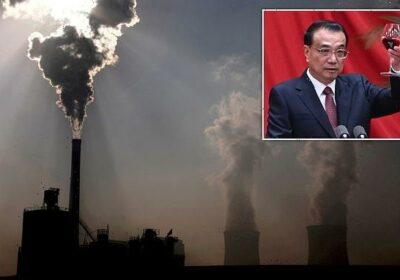China plans to build new coal-fired plants after blackouts last week

China plans to build new coal-fired plants after blackouts last week in a move set to cause alarm ahead of the COP26 summit in Glasgow
- Beijing plans to built new coal-fired plants after being hit by blackouts last week
- China had committed to hitting peak emissions in 2030, carbon neutral by 2060
- But Premier Li Keqiang announced plan to gather evidence, rethink the roadmap
- Move is likely to cause alarm ahead of the COP26 summit at the end of the month
China plans to build new coal-fired plants after the country was hit by blackouts last week in a move set to cause alarm ahead of the COP26 summit at the end of the month.
A statement from Beijing’s National Energy Commission today said energy security would become a priority following the outages and that China would rethink emissions targets.
Beijing had previously committed to hitting peak emissions in 2030 and being carbon neutral by 2060 – a target which would involve the closure of more than 600 coal plants.
But today’s statement hinted Beijing will build more coal-fired plants as China seeks to enhance the ‘capacity for energy self-supply’ and create a ‘modern energy system’.
China plans to build new coal-fired plants after the country was hit by blackouts last week in a move set to cause alarm ahead of the COP26 summit at the end of the month (file photo)
Chinese premier Li Keqiang said: ‘Energy security should be the premise on which a modern energy system is built and and the capacity for energy self-supply should be enhanced,’ the Guardian reported.
‘Given the predominant place of coal in the country’s energy and resource endowment, it is important to optimise the layout for the coal production capacity, build advanced coal-fired power plants as appropriate in line with development needs, and continue to phase out outdated coal plants in an orderly fashion.
‘Domestic oil and gas exploration will be intensified.’
Chinese premier Li Keqiang said officials want to gather new evidence to rethink a roadmap for reaching peak emissions, with the deadline likely to be extended beyond 2030
Keqiang added officials want to gather new evidence to rethink a roadmap for reaching peak emissions, with the deadline likely to be extended beyond 2030.
The premier said he had ordered ‘in-depth studies and calculations in light of the recent handling of electricity and coal supply strains, to put forward a phased timetable and roadmap for peaking carbon emissions.’
It came after blackouts hit cities across China last week amid a spike in demand for energy around the globe.
The country was so short on power that cities were hit by blackouts with factories forced to close or else open for just a couple of hours per week.
The crisis, which began biting a fortnight ago, was caused by the cost of coal spiking as the economy reopened post-Covid, meaning power stations were operating at a loss and began to shut down.
Power outages were reported in southern Guangdong province, but are most severe in the north eastern manufacturing hubs of Heilongjiang, Jilin and Liaoning.
And an additional 16 provinces were forced to ration energy due to a shortage in supply, but avoided full-scale blackouts.
China’s coal mines have been ordered to ramp up production to help ease the shortage, with rolling blackouts hitting some cities and factories forced to close down
In response, Shanxi – China’s biggest coal-producing region – ordered its 98 coal mines to raise their annual output capacity by 55.3 million tonnes and allowed 51 coal mines that had hit their maximum annual production levels to keep producing.
In China’s No. 2 coal region, Inner Mongolia, 72 mines were told that they could operate at higher capacities immediately, provided they ensure safe production.
It comes amid a wider energy crisis that has seen shortages and soaring prices in Europe, India and China.
Even before the current energy crisis erupted, the world was far behind on efforts to avert catastrophic climate change.
The United Nations estimates that global emissions will be 16 per cent higher in 2030 than they were in 2010 based on countries’ current pledges.
Source: Read Full Article


